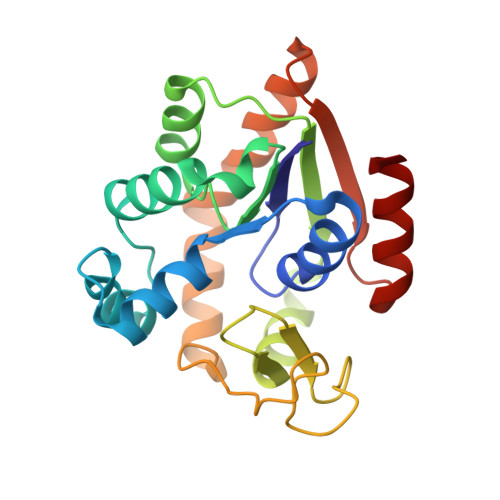Dynamic Connection between Enzymatic Catalysis and Collective Protein Motions.
Ojeda-May, P., Mushtaq, A.U., Rogne, P., Verma, A., Ovchinnikov, V., Grundstrom, C., Dulko-Smith, B., Sauer, U.H., Wolf-Watz, M., Nam, K.(2021) Biochemistry 60: 2246-2258
- PubMed: 34250801
- DOI: https://doi.org/10.1021/acs.biochem.1c00221
- Primary Citation of Related Structures:
7APU - PubMed Abstract:
Enzymes employ a wide range of protein motions to achieve efficient catalysis of chemical reactions. While the role of collective protein motions in substrate binding, product release, and regulation of enzymatic activity is generally understood, their roles in catalytic steps per se remain uncertain. Here, molecular dynamics simulations, enzyme kinetics, X-ray crystallography, and nuclear magnetic resonance spectroscopy are combined to elucidate the catalytic mechanism of adenylate kinase and to delineate the roles of catalytic residues in catalysis and the conformational change in the enzyme. This study reveals that the motions in the active site, which occur on a time scale of picoseconds to nanoseconds, link the catalytic reaction to the slow conformational dynamics of the enzyme by modulating the free energy landscapes of subdomain motions. In particular, substantial conformational rearrangement occurs in the active site following the catalytic reaction. This rearrangement not only affects the reaction barrier but also promotes a more open conformation of the enzyme after the reaction, which then results in an accelerated opening of the enzyme compared to that of the reactant state. The results illustrate a linkage between enzymatic catalysis and collective protein motions, whereby the disparate time scales between the two processes are bridged by a cascade of intermediate-scale motion of catalytic residues modulating the free energy landscapes of the catalytic and conformational change processes.
- Department of Chemistry, Umeå University, Umeå SE-90187, Sweden.
Organizational Affiliation:


















